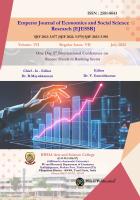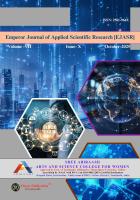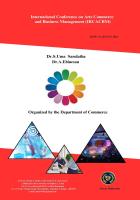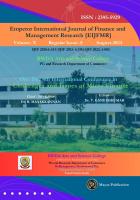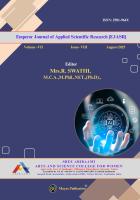- Home
- Books
-
Conference
- "INTERNATIONAL PERSPECTIVES ON RESEARCH METHODOLOGY: CHALLENGES AND OPPORTUNITIES"
- Artificial Intelligence in Finance and Economics
- Behavioral finance
- Day 5th International conference Recent Trends in Banking Sector
- International Conference on Innovations and Transformations Impacting Economy and Business in the Digital Era
- International Conference on Multidisciplinary Research Towards Sustainable Developmen
- International Conference on Social Science, Management and Technology Modern Era
- Two Day International Conference on Financial Innovation and Economic Development
- Emperor Award Name
- International Conference on Multidisciplinary Research
- Journals
- Research Projects
- Services
- Submit Article
- Video Gallery
Introduction to Information Theory and Coding
About the book
Description
Information Theory and Coding may be the fastest growing technologies in the field of Communication and network security. One of the ramifications of that growth is a dramatic increase in the number of professions-where an understanding of these technologies is essential for success-and a proportionate increase in the number and types of students taking course to learn about them.
Features of the Book
Several features of this text are designed to make it particularly easy for students to understand information theory and coding.
Course Objectives
Course objectives are clearly defined at initial for all the chapters.
Structure
This textbook is designed for students with little or no background in telecommunications or data communications. For this reason, we use a bottom-up approach. With this approach, students learn first about information system (bottom up approach) followed by generating the code words and code vectors using linear block codes and cyclic codes respectively.
Visual Approach
The book presents highly technical subject matter without complex formulas by using a balance of text and figures. More than 200 figures accompanying provide a visual and intuitive opportunity for understanding the material. Figures are particularly important and explaining coding concepts, which are based on connections and transmissions. Both of these ideas are easy to grasp visually. Highlighted Points We emphasize important concepts in highlighted boxes for quick references and immediate attention. Recommended Reading Each chapter includes a list of books and sites that can be used for further reading.
Highlighted Points
We emphasize important concepts in highlighted boxes for quick references and immediate attention.
Recommended Reading
Each chapter includes a list of books and sites that can be used for further reading.
Key Terms
Each chapter includes a list of key terms for the student.
Practice Set
Each chapter includes a practice set designed to reinforce and apply Salient concepts. It consists of two parts: descriptive questions and model exam question papers (end of all the chapters). Descriptive questions are intended to test the students first-level understanding of the material presented in the chapter. Multiple choice questions are designed to create motivation for the students to appear in the competitive examinations. Examination questions require deeper understanding of the material.
Index
The book contains an extensive list of acronyms.
Organization
The following lists the course material in the organization of the book:
1. Chapter 1 discusses the brief Introduction of Information Theory.
2. Chapter 2 deals with the generation of code words Source coding.
3. Chapter 3 describes the various Communication Channels in the field of Communication.
4. Chapter 4 discusses Error Control Codes for Linear Block Codes.
5. Chapter 5 discuses Binary Cyclic Codes.
6. Chapter 6 discusses Important Cyclic codes
7. Chapter 7 deals with the convolution codes.
Instructional Materials
Instructional materials for both the student and the teacher are provided. The solutions to exercises contain both the explanation and answer including full colored figures or tables when needed. The PowerPoint presentations are more comprehensive and include text and figures.
Contents
The book is divided into seven parts. The first part is an introduction to Information theory; the second part is Source Coding; the third part is Informational Channels; fourth chapter is Error Control Coding; Binary Cyclic codes are discussed in Chapter 5; Chapter 6 covers some important Cyclic codes and Chapter 7 covers the Convolution codes. The following summarizes the contents of each part.
How to Use the Book
This book is written for both an academic and a professional audience. The book can be used as a self-study guide for interested professionals. As a textbook, it can be used for a one-semester course. The following are some guidelines. Parts one to three are strongly recommended. Parts four to seven can be covered to detect and correct the errors that lead to improve the efficiency of communication system. The book is intended for undergraduate and postgraduate students of Electronics and Communication Engineering, Computer Science and Engineering, Information Technology and Telecommunication Engineering. The course material in this book is already taught to students for many years by the author; and the book is written with better understanding of the needs of the students and the practicing engineers in the subject. Acknowledgements It is obvious that the development of a book of this scope needs the support of many people. Peer Review The most important contribution to the development of a book such as this comes from peer reviews. We cannot express our gratitude in words to the many reviewers who spent numerous hours reading the manuscript and providing us with helpful comments and ideas. We would especially like to acknowledge the contribution of the following reviewers for this book. 1. M.Pavithra, M.E., Assistant Professor, Tamilnadu. Rajendiran Assistant Professor, Suriya Institute of Engineering and Technology, Vilupuram, Tamilnadu. 3. Dr. Senthil Kumar MGR University, Professor of Computer Science Chennai.
Just like any other book, this book being the first edition is bound to have some errors and omissions, which may please be bought to the notice of the authors or publisher to come with improvement in the second edition. All suggestions and Critical comments are most welcome. We pledge our sincere sense of gratitude to our parents and all our family members for their constant support and encouragement. We wish to thank our respected his holiness Pujya Shri. Dr. Siddharama Swamiji, President, SSET, Belagavi, Shri S. G. Sambaragimath, Chairman, S. G. B. I. T, Belagavi, Dr. S. S. Salimath, Principal, S G Balekundri Institute of Technology, Belagavi, Dr. K. S. Prabhushetty, Professor and Head, Department of Electronics and communication Engineering, S. G. Balekundri Institute of Technology, Belagavi for their encouragement to carry out this work. Also we would like to express our sincere gratitude to Panchajanya Vidyapeetha Welfare Trust, Bangalore, Dr. C Nanjundaswamy, Principal, Dr. Ambedkar Institute of Technology, Bangalore and Dr. Yamunadevi C R, Professor and Head, Department of Telecommunication Engineering, Dr. Ambedkar Institute of Technology, Bangalore for their constant support and encouragement. Our sincere thanks to Dr. Venugopal K. R., Vice-Chancellor, Bangalore University, Bangalore and Dr. K. B. Raja, Professor and Chairman, University Visvesvaraya College of Engineering, Bangalore for their constant support and encouragement. We wish to thank all our staff and teaching faculties for their inputs at various stages of writing the book including the feedback from our students. I express my grateful thanks to Dr. R. Mayakkanan and their members of the staff, for their efforts in publishing this book. Our sincere thanks to Mr. Muthu S, page designer for excellent typesetting of the manuscript. Suggestions for improvement of the book are welcome.
Details
ISBN
978-93-87756-20-5
Imprint
Mayas Publication
Published
2019
Copyright
Copyright © 2025 Mayas Publication
Publishing Limited. All rights reserved.
You currently don’t have access to this book, however you can purchase separate chapters directly from the table of contents or buy the full version.
Purchase the book
